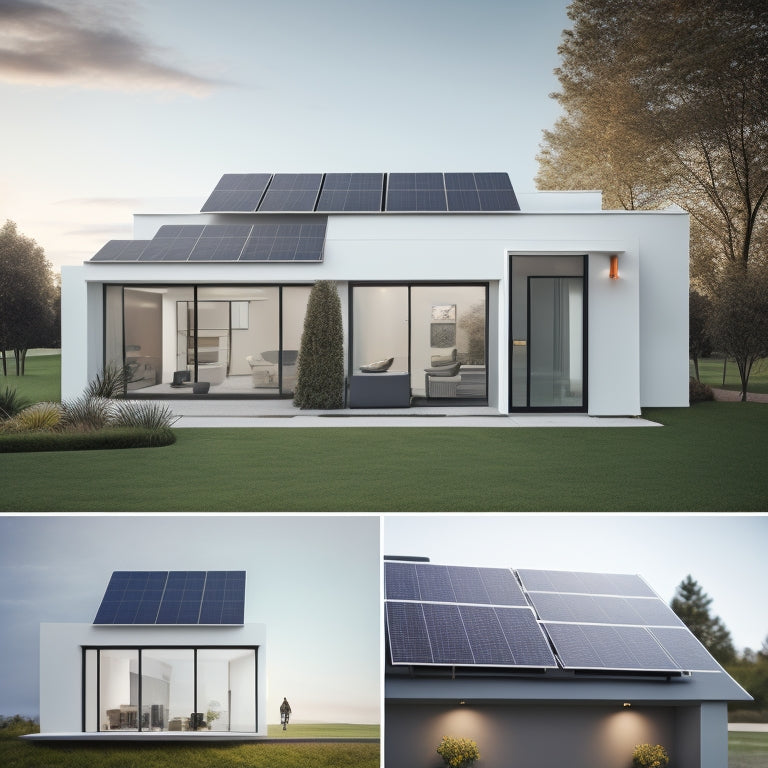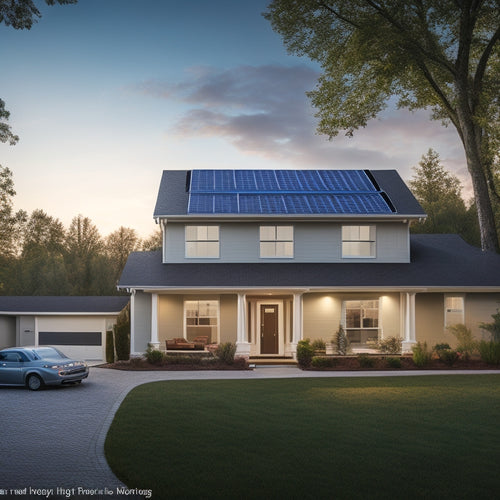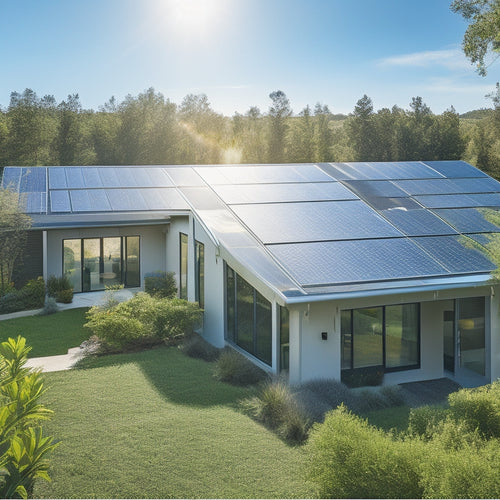
Solar Panel Home Battery Bank
Share
With a solar panel home battery bank, you can access a reliable and consistent power supply, utilizing the excess energy generated during the day to fuel your evening activities, from cooking and lighting to entertainment, without relying on the grid. This means you can enjoy nighttime energy usage, reduce your reliance on non-renewable energy sources, and minimize energy waste. By understanding your daily power consumption and monitoring your energy usage, you can optimize your battery configuration and maximize your energy independence. As you investigate the world of solar panel home battery banks, you'll uncover how to get the most out of your system.
The Essentials
- A solar panel home battery bank enables energy usage beyond daylight hours, providing a consistent power supply for evening activities.
- It enhances energy efficiency and reduces reliance on non-renewable energy sources, ensuring reliable power storage even during grid outages.
- Effective battery management is crucial, considering factors like life expectancy, cycle depth capacity, and thermal management to optimize lifespan.
- Lithium-ion batteries are a popular choice, offering up to 5,000 charge cycles and over 15 years of lifespan with proper maintenance.
- A well-configured solar panel home battery bank can lead to significant cost reductions, increased reliability, and enhanced energy independence.
Energy Independence at Night
With a solar panel home battery bank, you're not limited to using solar energy only during the day.
By leveraging Home Energy Storage solutions, you can optimize your energy efficiency and reduce your reliance on non-renewable energy sources.
You can power your evening hours with the excess energy stored in your battery bank, reducing your reliance on the grid.
Powering Evening Hours
Your evening hours are typically when you need the most power, as you switch on lights, TVs, and kitchen appliances. During this time, you rely heavily on your solar panel home battery bank to meet your energy demands. To guarantee you have a consistent supply of power, it's crucial to optimize your battery usage for nighttime hours.
| Time of Day | Energy Demand |
|---|---|
| 6:00 pm - 8:00 pm | High (cooking, lighting, entertainment) |
| 8:00 pm - 10:00 pm | Medium (TV, computers, refrigeration) |
| 10:00 pm - 12:00 am | Low (standby, security systems) |
Stored Energy Availability
During evening hours, when your solar panel home battery bank is shouldering the load, the availability of stored energy becomes critical. You'll want to make certain that your energy storage system can provide a reliable supply of power when the sun isn't shining. This is where the concept of stored energy availability comes into play.
With a reliable storage solution, you can avoid frustrating issues such as high electricity bills due to unpredictable grid rates and unexpected power outages Renewable Energy. The amount of energy available for use is directly tied to the energy conversion efficiency of your battery bank. A higher efficiency rating means more usable energy is stored, giving you greater freedom from the grid.
When integrated with renewable energy sources like solar, your battery bank becomes a crucial component of your energy independence. To maximize stored energy availability, it's important to take into account factors such as battery type, capacity, and depth of discharge.
Zero Energy Waste Guarantee
You want to guarantee that the energy harvested from your solar panels is used efficiently and effectively.
By utilizing off grid solar battery systems and deep cycle batteries, you can store excess energy for later use, reducing waste and maximizing your energy independence.
With a reliable power storage system, you can assure that no energy goes to waste, even when the grid is down.
Energy Harvested Efficiently
Most solar panel installations are designed to generate more energy than a home can consume at any given time, resulting in excess energy that's fed back into the grid. This excess energy can be a waste if not employed efficiently.
With a solar panel home battery bank, you can optimize your energy harvest and reduce energy waste.
By integrating smart technology and energy management systems, you can monitor and control your power generation and consumption in real-time. This allows you to adjust your energy usage to match your energy production, ensuring maximum solar efficiency.
With a battery integration system, you can store excess energy generated during the day for use during the night or on cloudy days, reducing your reliance on the grid. This not only saves you money but also enables you to practice sustainable living and reduce your carbon footprint.
Power Storage Reliability
One of the most significant advantages of a solar panel home battery bank is its ability to guarantee power storage reliability, assuring zero energy waste.
You can rest assured that the energy generated by your solar panels is stored efficiently, thanks to advanced battery backup systems. These systems are designed to mitigate grid integration challenges, ensuring a seamless shift between grid power and stored energy.
With a reliable power storage system, you'll never have to worry about losing excess energy generated during the day. Instead, you can store it for later use, reducing your reliance on the grid and minimizing energy waste.
This means you'll have a consistent power supply, even during outages or when the grid is down. In addition, a reliable power storage system enables you to optimize your energy usage, shifting non-essential loads to off-peak hours and reducing peak demand charges.
Deep Cycle Battery Technology
When selecting a deep cycle battery for your solar panel home battery bank, you'll want to take into account two key factors: battery life expectancy and cycle depth capacity.
With the right deep cycle battery technology, you can guarantee a reliable and long-term power supply, especially when paired with a grid tie system, which allows you to sell excess energy back to the grid.
Battery life expectancy refers to the number of years a battery will last, while cycle depth capacity measures how deeply a battery can be discharged before it needs to be recharged.
Battery Life Expectancy
Deep cycle batteries, the heart of your solar panel home battery bank, are built to last, but they don't last forever. You need to understand the factors affecting their lifespan to maximize their performance and extend their life.
Proper battery maintenance, such as keeping them clean and dry, is vital. Charging efficiency also plays a significant role, as it prevents overheating and reduces degradation rates. Energy density, thermal management, and battery chemistry are key factors that impact lifespan.
By understanding these factors, you can optimize your battery's performance and extend its life. Additionally, usage tips, such as avoiding deep discharges and minimizing idle time, can help prolong its lifespan.
When your batteries finally reach the end of their life, consider recycling options to reduce waste and minimize cost considerations.
Cycle Depth Capacity
Frequently, solar panel home battery banks rely on deep cycle batteries that can handle repeated charge and discharge cycles without compromising their performance.
As you're considering a battery bank for your solar panel system, you'll want to understand the significance of cycle depth capacity. This refers to the percentage of the battery's capacity that you can safely use without harming the battery.
When you discharge a deep cycle battery, you're using some of its capacity. The cycle depth capacity determines how much of that capacity you can use before recharging. A higher cycle depth capacity means you can use more of the battery's capacity without reducing its lifespan.
For example, if you have a 100Ah battery with an 80% cycle depth capacity, you can safely use 80Ah of its capacity before recharging.
Effective capacity management is essential to guarantee ideal cycle performance. By understanding your battery's cycle depth capacity, you can avoid over-discharging, which can lead to premature wear and tear.
This allows you to maximize your battery's lifespan and enjoy the freedom of reliable, off-grid energy storage.
Count Your Daily Wattage
You need to calculate your daily power consumption to determine the right size of your solar panel home battery bank.
To do this, you'll want to track your energy usage patterns, including the wattage and duration of each device or appliance you use daily.
With a reliable home energy storage solutions in place, you can store excess energy generated by your solar panels for later use.
Daily Power Consumption
Your household's power profile plays a critical role in determining the best solar panel home battery bank configuration. To get a clear overview of your daily power consumption, you'll need to track your energy usage over a period of time. This involves monitoring your power tracking devices to identify peak usage hours, standby power consumption, and overall energy demand. A thorough consumption analysis will help you understand how much power you require to meet your daily needs.
Start by making a list of your appliances, their wattage, and the number of hours they're used daily. This will give you an idea of your total daily wattage. Be sure to include smaller devices like smartphones, laptops, and LED lights, as they can add up quickly.
Consider using a power monitoring system or smart plugs to track your energy usage in real-time. This data will be essential in determining the ideal battery bank size and configuration for your solar panel home battery bank.
Energy Usage Patterns
As you compile your list of appliances, their wattage, and daily usage hours, patterns begin to emerge. You'll notice peak usage times, such as morning and evening when lights, refrigerators, and HVAC systems consume the most energy.
This understanding is vital for optimizing energy efficiency and demand response. By grasping your consumption habits, you can adjust your daily routine to reduce peak usage and minimize strain on the grid.
Effective load management is essential for seamless solar integration. By monitoring your energy usage, you can predict and prepare for periods of high demand.
This enables you to utilize renewable resources efficiently, reducing your reliance on the grid and maximizing your energy independence. With advanced energy monitoring and usage forecasting, you can fine-tune your system to respond to changing energy needs, ensuring a smooth and efficient grid interaction.
Lithium-Ion Long Cycle Life
You'll benefit from lithium-ion batteries' long cycle life, which translates to a longer lifespan and reduced replacement costs.
A single lithium-ion battery can last for up to 5,000 charge cycles, making it a reliable choice for your solar panel home battery bank.
This means you'll enjoy a longer period of stable, efficient energy storage and generation.
Long Cycle Benefits
Lithium-ion batteries in a home battery bank boast an impressive long cycle life, which directly translates to a significant reduction in replacement costs over time. This means you'll enjoy a longer period of worry-free energy independence, without the burden of frequent battery replacements.
With a lithium-ion battery bank, you can expect to see a lifespan of up to 15 years or more, depending on your specific usage and battery maintenance tips. This extended lifespan allows you to maximize your solar efficiency improvements, as you'll be able to store and employ more of the energy generated by your solar panels.
As a result, you'll experience a significant decrease in your reliance on the grid, giving you the freedom to live life on your own terms. By choosing a lithium-ion battery bank, you're investing in a reliable and long-lasting energy storage solution that will provide you with years of uninterrupted power and peace of mind.
Frequently Asked Questions
Can I Use My Existing Solar Panel System With a Battery Bank?
You can definitely repurpose your existing solar panel system with a battery bank, but first, guarantee seamless solar panel integration by checking the compatibility of your panels' voltage and power output with the battery bank's requirements.
How Long Does It Take to Charge a Fully Depleted Battery Bank?
"When in Rome, do as the Romans do" - and when charging a fully depleted battery bank, you'll do it efficiently. It takes around 5-8 hours to recharge, depending on charging efficiency, which affects battery lifespan, so optimize your setup for maximum freedom from the grid.
Are Solar Panel Home Battery Banks Eligible for Government Incentives?
You're eligible for government incentives on renewable energy systems, including solar panel home battery banks, which can greatly reduce your upfront costs through incentive programs and attractive financing options, giving you the freedom to go green.
Can I Expand My Battery Bank Capacity in the Future if Needed?
As you plan for future energy needs, you'll be relieved to know that you can expand your battery bank capacity if needed, allowing you to scale up and store more energy for increased independence and flexibility.
Are Battery Banks Safe From Electrical Fires and Other Hazards?
You guarantee battery safety by prioritizing maintenance, like monitoring temperature and voltage, and following fire prevention measures, such as keeping them away from flammable materials, to minimize risks and enjoy your independence from the grid.
Final Thoughts
You've made the smart decision to invest in a solar panel home battery bank. Now, imagine having energy independence at night, without wasting a single watt. With deep cycle battery technology, you can count your daily wattage and enjoy a zero energy waste guarantee. Lithium-ion long cycle life guarantees your battery lasts for years to come. Some might worry about the initial cost, but think of it this way: every dollar spent now is a dollar saved on future energy bills, plus the peace of mind that comes with energy independence.
Related Posts
-

Top Camping Water Bottles for Adventure
When you're out adventuring, picking the right camping water bottle is essential for staying hydrated. Look for durab...
-

Cost of Solar With Battery Backup
You're investing in a solar panel system with battery backup to guarantee reliable power during outages. The cost of ...
-

Installing Metal Solar Roofs for Maximum Energy Efficiency
Installing metal solar roofs can drastically enhance your home's energy efficiency and durability. These roofs withst...


